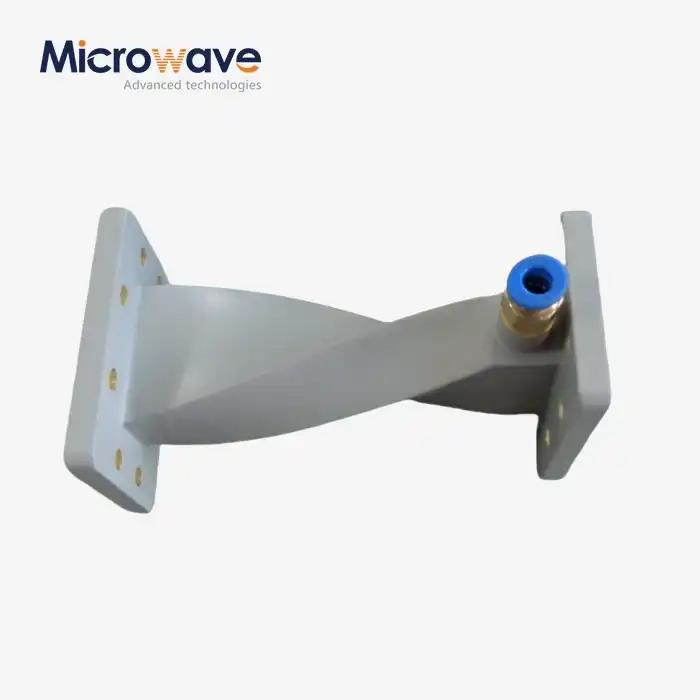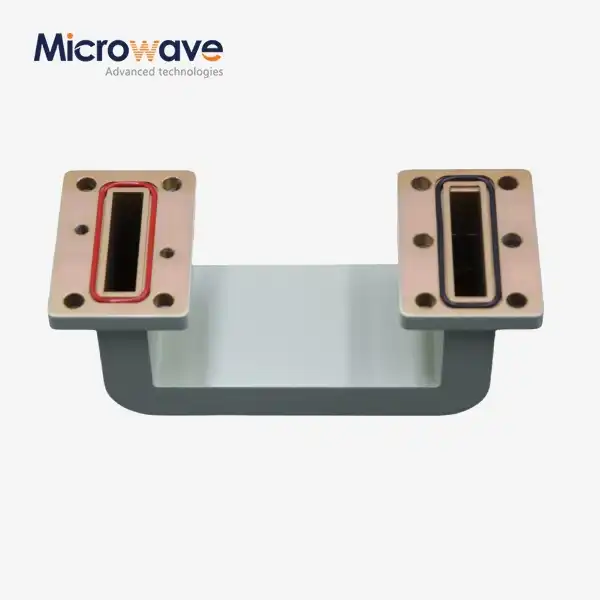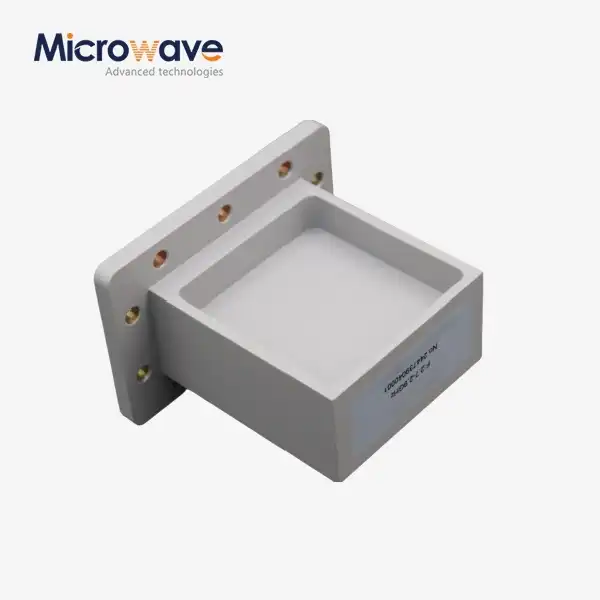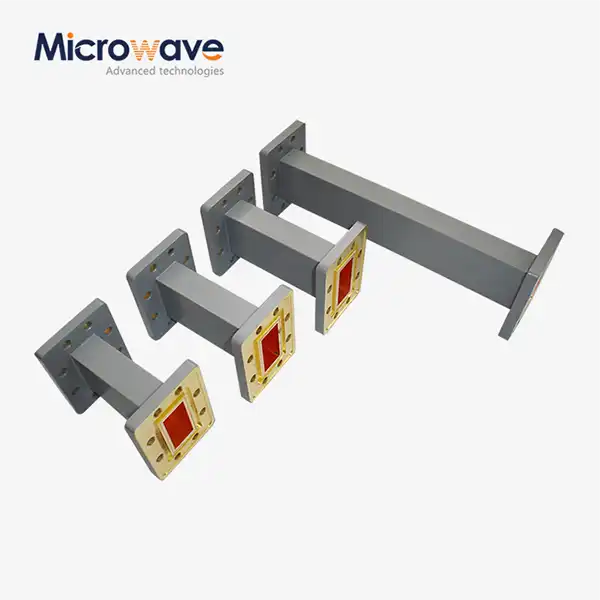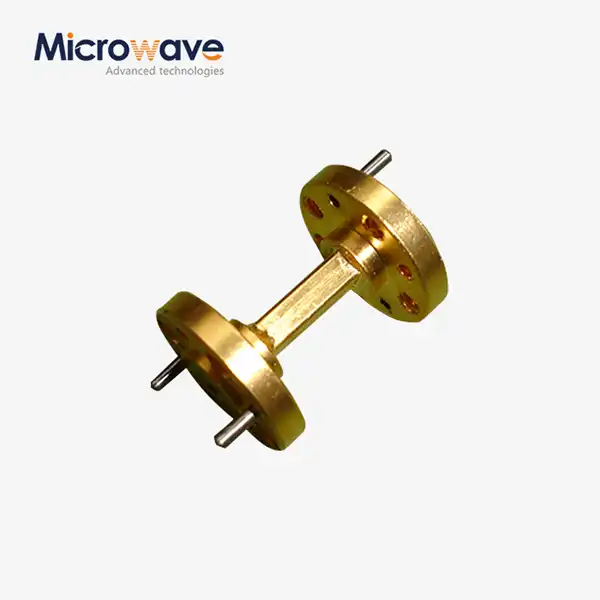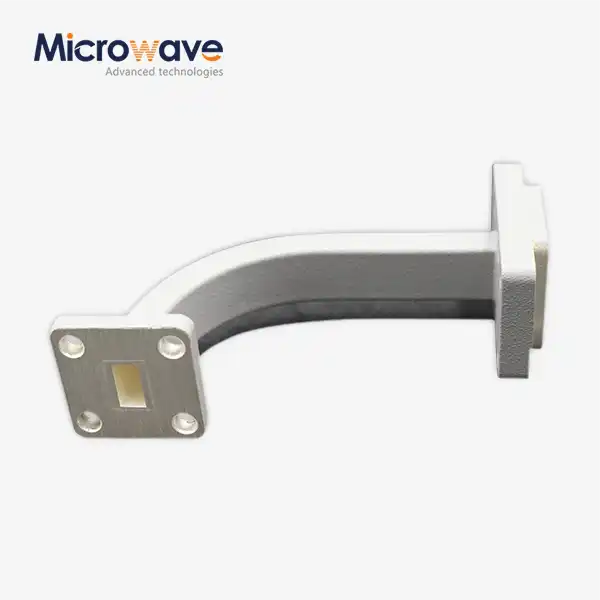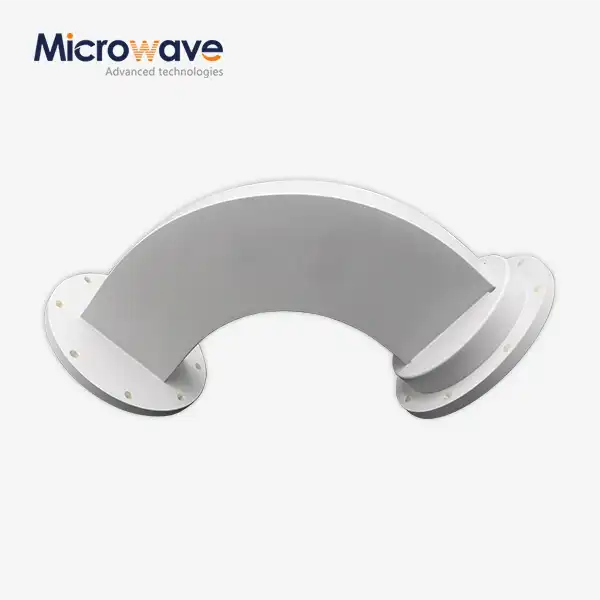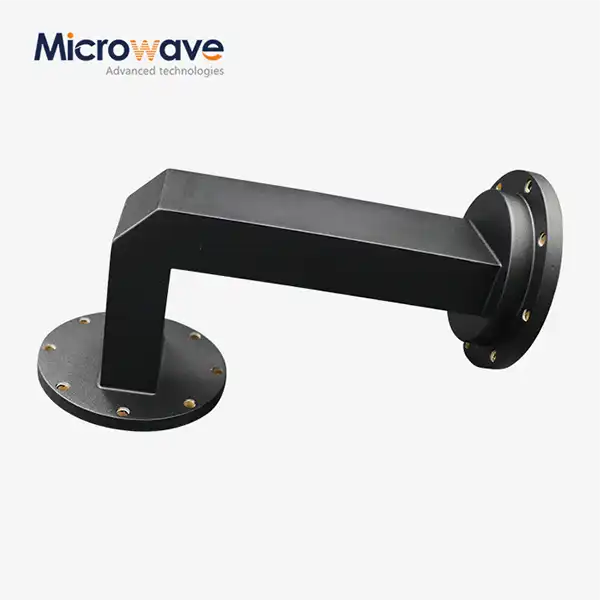What are the design principles of waveguide miter bends?
Waveguide miter bends represent critical components in microwave transmission systems, serving as essential elements for efficiently redirecting electromagnetic signals without compromising performance. The design principles of Waveguide Miter Bends involve careful consideration of geometric parameters, electromagnetic field behavior, and manufacturing precision to ensure optimal signal transmission. These principles encompass the precise calculation of bend angles, mitigation of reflection losses, and material selection to maintain signal integrity across the operational frequency range. Understanding these fundamental design concepts is crucial for engineers working with complex waveguide systems in applications ranging from satellite communications to radar installations.
Fundamental Design Considerations for Waveguide Miter Bends
Geometric Parameters and Their Impact
The geometric configuration of a Waveguide Miter Bend represents one of the most critical aspects of its design. The primary geometric parameter is the bend angle, which typically stands at 90 degrees for standard applications, though this can be customized based on specific system requirements. The internal dimensions of the waveguide must be precisely maintained throughout the bend to preserve the waveguide's characteristic impedance. Any dimensional inconsistency can introduce impedance mismatches, resulting in signal reflections and consequent power loss. Advanced Microwave Technologies employs high-precision manufacturing techniques to ensure dimensional accuracy down to micron-level tolerances, particularly important for higher frequency applications where even minor deviations can significantly impact performance.
Another crucial geometric consideration is the mitering technique itself. The miter joint must be designed to maintain phase coherence of the propagating wave as it navigates the bend. This involves calculating the exact position of the mitered surface to minimize phase distortion. For optimal performance, designers must account for the waveguide's cross-sectional dimensions, operating frequency, and polarization characteristics. The mitered surface acts as a reflective plane that redirects the incident wave without disturbing its mode structure. Advanced Microwave's engineering team utilizes sophisticated electromagnetic simulation tools to optimize these parameters across their entire range of Waveguide Miter Bend products, from the compact WR10 to the substantial WR2300 series, ensuring consistent performance across varying waveguide sizes.
The internal corner geometry of the Waveguide Miter Bend deserves special attention as it significantly influences the scattering parameters. Sharp corners can introduce higher-order modes and increase return loss, while properly designed rounded or chamfered corners help maintain signal integrity. The optimization of this feature depends on the specific application requirements, including bandwidth considerations, power handling capabilities, and insertion loss constraints. For applications demanding extremely low insertion loss, such as satellite communication systems, Advanced Microwave Technologies implements proprietary corner optimization techniques that have been refined through decades of manufacturing experience, resulting in Waveguide Miter Bend products with VSWR values consistently below 1.05 across the specified frequency range.

Material Selection and Manufacturing Considerations
Material selection plays a pivotal role in the performance and durability of Waveguide Miter Bends. The conductivity, machinability, weight, and thermal properties of the chosen material directly impact the component's electrical performance and mechanical stability. Advanced Microwave Technologies offers Waveguide Miter Bend components in various materials including aluminum for lightweight applications, copper for superior conductivity, and brass for excellent machinability and good electrical properties. Each material offers distinct advantages: aluminum provides weight savings critical for aerospace applications, copper maximizes electrical performance with minimal insertion loss, and brass offers an excellent balance of electrical and mechanical properties.
The manufacturing process for Waveguide Miter Bends demands exceptional precision to ensure consistent electrical performance. Advanced Microwave Technologies employs computer-controlled machining centers capable of achieving tolerances within ±0.001 inches, essential for maintaining the critical dimensions that determine impedance characteristics. The joining method for the mitered sections requires specialized techniques such as precision brazing or welding to ensure electrical continuity without introducing losses. After fabrication, each Waveguide Miter Bend undergoes plating with materials like silver or gold, which not only enhances conductivity but also provides protection against environmental factors that could degrade performance over time.
Quality control represents a critical aspect of the manufacturing process, with each Waveguide Miter Bend undergoing rigorous testing to verify compliance with design specifications. Advanced Microwave Technologies' ISO 9001:2008 certified facilities incorporate network analyzer measurements to verify VSWR performance across the entire operating frequency range, which can extend up to 110 GHz for specialized applications. The comprehensive testing regiment ensures that every Waveguide Miter Bend meets the strict performance criteria required for critical applications like radar systems and satellite communications, where component failure is not an option. The company's dedication to quality extends to maintaining environmental compliance, with all products meeting RoHS standards while maintaining operational integrity across temperatures ranging from -40°C to +85°C.
Electromagnetic Performance Optimization
The primary electromagnetic consideration in Waveguide Miter Bend design involves minimizing reflection and insertion losses while maintaining phase linearity across the operating bandwidth. This requires precise control of the internal geometry to maintain the proper propagation mode. For rectangular waveguides, which constitute the majority of microwave transmission systems, the dominant TE10 mode must be preserved throughout the bend without exciting higher-order modes that can degrade performance. Advanced Microwave's design approach incorporates sophisticated electromagnetic modeling techniques to predict and optimize mode conversion behavior, particularly critical in narrow bandwidth applications where signal purity is paramount.
Impedance matching represents another crucial aspect of electromagnetic performance optimization for Waveguide Miter Bends. Any discontinuity in the waveguide structure can create impedance variations that result in signal reflections, measured as Voltage Standing Wave Ratio (VSWR). Advanced Microwave Technologies' Waveguide Miter Bend products achieve exceptional VSWR performance of ≤ 1.05, indicating minimal reflections and maximum power transfer through the component. This level of performance is achieved through precision manufacturing combined with advanced design techniques that incorporate compensating structures at potential discontinuities. For applications requiring even lower VSWR, custom designs can include additional matching features optimized for specific frequency bands.
Power handling capability constitutes a critical performance parameter that influences the design of Waveguide Miter Bends, particularly for high-power radar and communication systems. The bend must be designed to withstand peak power levels without electrical breakdown or excessive heating that could lead to performance degradation. Factors influencing power capacity include internal surface finish, pressurization capabilities, and thermal management considerations. Advanced Microwave Technologies' Waveguide Miter Bend products undergo specialized surface treatment processes to minimize surface roughness, thereby reducing losses and enhancing power handling. For extremely high-power applications, the company offers pressurized designs with specialized seals that increase breakdown thresholds, allowing their Waveguide Miter Bend components to handle the substantial power levels required in modern radar and communication systems.
Advanced Design Techniques for Specialized Applications
Customized Angle Configurations
While the standard 90-degree Waveguide Miter Bend serves most applications effectively, many specialized systems require non-standard bend angles to accommodate spatial constraints or specific signal routing requirements. Advanced Microwave Technologies excels in designing and manufacturing customized angle configurations that maintain optimal electromagnetic performance regardless of the deviation from standard geometries. The engineering challenge intensifies with non-orthogonal angles, as the reflection characteristics at the mitered surface change significantly. For acute angles below 45 degrees, additional compensating structures may be required to maintain acceptable VSWR levels. Similarly, obtuse angles above 120 degrees present unique challenges in preserving mode purity and minimizing cross-polarization effects.
The design process for custom-angle Waveguide Miter Bends involves sophisticated electromagnetic simulation to optimize the mitered surface geometry specifically for the required angle. Advanced Microwave's engineering team employs finite element analysis and method of moments techniques to predict performance across the operating frequency band. This electromagnetic modeling allows for the development of precisely tailored Waveguide Miter Bend solutions for applications with strict spatial requirements, such as tightly packed satellite payload compartments or complex radar antenna feed networks. The company's experience in custom angle configurations spans decades, with successful implementations ranging from subtle 85-degree bends for fine-tuning signal paths to extreme 135-degree bends for specialized antenna systems.
The manufacturing complexity increases substantially for non-standard angle Waveguide Miter Bends, requiring specialized fixtures and enhanced quality control procedures. Advanced Microwave Technologies has developed proprietary manufacturing techniques to maintain dimensional accuracy even for the most challenging angle configurations. Each custom-angle Waveguide Miter Bend undergoes individual performance verification to ensure that the electromagnetic characteristics meet or exceed the specified requirements across the operational frequency range. This meticulous approach to quality control enables Advanced Microwave to guarantee consistent performance for even the most demanding applications, providing customers with confidence that their specialized Waveguide Miter Bend components will perform as designed when integrated into complex microwave systems.
Multi-Plane Routing Solutions
Complex microwave systems often require signal routing in multiple planes, necessitating specialized Waveguide Miter Bend configurations that combine bends in different axes. These multi-plane routing solutions represent some of the most challenging design scenarios in waveguide technology, requiring careful consideration of cumulative effects on signal propagation. Advanced Microwave Technologies has developed expertise in creating optimized multi-plane configurations that minimize the overall insertion loss and VSWR while maintaining phase linearity through the complete assembly. These solutions often involve combinations of E-plane and H-plane bends, each with distinct electromagnetic characteristics that must be carefully balanced to preserve signal integrity.
The design process for multi-plane Waveguide Miter Bend assemblies requires system-level thinking, considering the interaction between successive bends and their cumulative impact on the propagating signal. Factors such as the spacing between bends, their relative orientation, and the potential for mode conversion at each junction must be carefully analyzed. Advanced Microwave Technologies employs specialized 3D electromagnetic simulation tools to model complete multi-plane assemblies, optimizing the overall performance rather than treating each bend as an isolated component. This holistic approach enables the development of Waveguide Miter Bend solutions for the most demanding applications, such as compact satellite communication terminals where space constraints necessitate complex signal routing while maintaining exceptional RF performance.
The manufacturing of multi-plane Waveguide Miter Bend assemblies presents unique challenges in ensuring dimensional accuracy across multiple axes and maintaining precise alignment between sections. Advanced Microwave Technologies has invested in multi-axis machining capabilities and advanced assembly techniques to address these challenges. Each multi-plane assembly undergoes comprehensive testing that evaluates not only standard parameters like VSWR and insertion loss but also phase tracking characteristics critical for systems like phased array antennas. The company's ability to create complex multi-plane Waveguide Miter Bend solutions has proven invaluable for customers in the aerospace and defense sectors, where spatial efficiency and electromagnetic performance must coexist without compromise in sophisticated systems operating at frequencies up to 110 GHz.

Broadband Performance Enhancement
While traditional Waveguide Miter Bend designs provide excellent performance within the standard waveguide bandwidth (typically a frequency ratio of 1.5:1), many modern systems demand broader operational bandwidths to support multiple services or wideband signals. Enhancing the broadband performance of Waveguide Miter Bends requires specialized design approaches that address the frequency-dependent behavior of the mitered junction. Advanced Microwave Technologies has developed proprietary techniques for extending the usable bandwidth of their Waveguide Miter Bend products, enabling applications such as multi-band satellite transponders and wideband radar systems to maintain consistent performance across expanded frequency ranges.
The key to broadband performance lies in controlling the frequency-dependent phase shifts and reflections that naturally occur at the mitered junction. Advanced Microwave's enhanced Waveguide Miter Bend designs incorporate carefully optimized matching structures that compensate for these variations across the frequency band. These structures may include precisely sized and positioned posts, irises, or stepped sections that collectively create a more consistent impedance profile. The company's engineering team leverages decades of experience combined with advanced simulation tools to develop these enhanced Waveguide Miter Bend solutions, which maintain VSWR performance below 1.1 across bandwidths exceeding the standard waveguide recommendations.
Implementation of broadband Waveguide Miter Bend solutions requires exceptional manufacturing precision, as the effectiveness of the matching structures depends on tight dimensional control. Advanced Microwave Technologies employs high-precision machining centers coupled with specialized quality control procedures to ensure that each broadband Waveguide Miter Bend meets its performance specifications. The broadband capabilities prove particularly valuable for systems operating in the millimeter-wave region (above 30 GHz), where available bandwidth is at a premium. The company's broadband Waveguide Miter Bend products have been successfully deployed in applications ranging from 5G backhaul networks to scientific instrumentation operating at W-band (75-110 GHz), providing customers with flexible components that maintain high performance across expanded frequency ranges while offering the durability and reliability inherent to waveguide technology.
Application-Specific Design Optimizations
Satellite Communication Requirements
Satellite communication systems present some of the most demanding requirements for Waveguide Miter Bend components, necessitating specialized designs that balance electrical performance with weight considerations and environmental resilience. In satellite payloads, every gram matters, making lightweight yet robust Waveguide Miter Bend designs essential. Advanced Microwave Technologies addresses this challenge through material selection and structural optimization, offering aluminum Waveguide Miter Bend components with wall thicknesses precisely calculated to provide necessary mechanical strength while minimizing mass. For even more weight-critical applications, the company has developed thin-wall copper-plated aluminum designs that combine the conductivity advantages of copper with the weight benefits of aluminum, resulting in Waveguide Miter Bend components that maximize electrical performance without imposing significant mass penalties on the satellite system.
The space environment imposes unique challenges on Waveguide Miter Bend components, including thermal cycling, vacuum conditions, and radiation exposure. Advanced Microwave Technologies' satellite-grade Waveguide Miter Bend products incorporate special design features to maintain performance under these extreme conditions. Thermal stability is achieved through careful material selection and specialized joining techniques that accommodate differential expansion across the wide temperature range experienced in orbital operations (-40°C to +85°C). Vacuum compatibility requires elimination of potential outgassing materials and special consideration of surface treatments. The company's space-qualified Waveguide Miter Bend components undergo rigorous testing including thermal vacuum cycling and vibration resistance to verify their suitability for long-duration missions where reliability is paramount.
Signal integrity represents a critical consideration for satellite communication applications, where every fraction of a decibel matters in the link budget. Advanced Microwave Technologies optimizes their Waveguide Miter Bend designs for minimum insertion loss through precision manufacturing and enhanced surface finishing techniques. The internal surfaces receive specialized treatments that reduce surface roughness to values below 0.2 microns, minimizing resistive losses particularly important at higher frequencies. The company's satellite-grade Waveguide Miter Bend components achieve insertion loss figures that approach theoretical limits, typically less than 0.05 dB at mid-band frequencies. This exceptional performance has made Advanced Microwave a preferred supplier for major satellite manufacturers worldwide, with their Waveguide Miter Bend components functioning reliably in numerous commercial and government satellite systems across multiple frequency bands from C-band through Ka-band and beyond.
Radar System Integration
Radar systems present unique challenges for Waveguide Miter Bend design due to their combination of high power levels, precise phase requirements, and often harsh operational environments. Advanced Microwave Technologies has developed specialized Waveguide Miter Bend solutions optimized for radar applications, with particular attention to power handling capabilities and phase stability. The high-power versions incorporate enhanced internal finishing techniques and can be pressurized to prevent breakdown at the power levels typical in modern radar systems. The careful control of phase characteristics ensures that when integrated into complex antenna feed networks, the Waveguide Miter Bend components maintain the precise phase relationships essential for accurate beam forming and target resolution.
Airborne and shipboard radar systems demand Waveguide Miter Bend components that can withstand mechanical stress including vibration, shock, and acceleration forces. Advanced Microwave Technologies addresses these requirements through robust mechanical design and rigorous environmental testing. The company's radar-grade Waveguide Miter Bend products undergo qualification testing that simulates operational conditions, ensuring they maintain both mechanical integrity and electrical performance when subjected to the stresses encountered in mobile platforms. Special attention is given to the joining methods and structural reinforcement at the mitered junction, which represents a potential mechanical weakness if not properly designed. These enhancements ensure that Advanced Microwave's Waveguide Miter Bend components provide reliable service in the most demanding operational environments.
The growing trend toward active electronically scanned array (AESA) radar systems has introduced new requirements for Waveguide Miter Bend components, particularly in terms of size, weight, and integration with active components. Advanced Microwave Technologies has responded with compact Waveguide Miter Bend designs specifically optimized for the tight spacing requirements of modern array architectures. These specialized components maintain exceptional electrical performance while accommodating the spatial constraints inherent in densely packed arrays. The company's expertise in precision manufacturing enables the production of miniaturized Waveguide Miter Bend components with the dimensional accuracy required for millimeter-wave frequencies, where tolerances become increasingly critical. This capability has positioned Advanced Microwave as a valuable partner for defense contractors developing next-generation radar systems operating at frequencies up to 110 GHz, where their Waveguide Miter Bend components provide essential signal routing functions while maintaining the phase coherence required for advanced signal processing techniques.
Telecommunication and Industrial Applications
Beyond the demanding aerospace and defense sectors, Waveguide Miter Bend components play crucial roles in terrestrial telecommunication networks and industrial systems where reliability and cost-effectiveness must be balanced. Advanced Microwave Technologies has developed optimized designs for these commercial applications, focusing on manufacturing efficiency without compromising essential performance characteristics. For telecommunication backhaul networks operating at microwave frequencies, the company offers Waveguide Miter Bend products that provide the durability and weather resistance required for outdoor installations while maintaining the low insertion loss needed for efficient link budgets. These components typically feature aluminum construction with weather-resistant finishes, designed to provide decades of reliable service in exposed environments ranging from desert heat to arctic cold.
Industrial applications including medical equipment, scientific instrumentation, and manufacturing systems often utilize waveguide technology for its power handling capabilities and electromagnetic isolation properties. Advanced Microwave Technologies provides specialized Waveguide Miter Bend solutions for these diverse applications, with designs tailored to specific requirements such as cleanroom compatibility for semiconductor manufacturing equipment or non-magnetic construction for medical imaging systems. The company's application engineering team works closely with customers to understand their unique needs, developing custom Waveguide Miter Bend configurations that address specific constraints while maintaining compliance with relevant industry standards.
The growing market for millimeter-wave applications in 5G networks, automotive radar, and industrial sensing has created demand for high-precision Waveguide Miter Bend components operating at frequencies above 30 GHz. Advanced Microwave Technologies has invested in specialized manufacturing capabilities to address this emerging market, offering Waveguide Miter Bend products with the micron-level precision required for these high-frequency applications. The company's expertise in high-frequency design enables the development of components that maintain mode purity and low insertion loss even at W-band frequencies (75-110 GHz), where waveguide dimensions shrink to millimeter scale. This capability positions Advanced Microwave as a valuable partner for companies developing next-generation communication and sensing systems that leverage the wide bandwidths available at millimeter-wave frequencies, providing them with Waveguide Miter Bend components that combine precision performance with production scalability.
Conclusion
The design principles of Waveguide Miter Bends encompass a complex interplay of geometric precision, material selection, and electromagnetic optimization to achieve reliable signal routing in microwave systems. From fundamental considerations like bend angle and internal geometry to advanced techniques for multi-plane routing and broadband performance, these principles guide the development of components that maintain signal integrity across diverse applications.
Looking to implement high-performance Waveguide Miter Bends in your microwave system? Advanced Microwave Technologies offers industry-leading solutions backed by over 20 years of manufacturing excellence. Our perfect supply chain system, professional R&D team, and strict quality control ensure products that meet your exact specifications. Whether you need standard components or custom designs, our global export capabilities and strong after-sales support provide the reliability your project demands. Contact us today at sales@admicrowave.com to discuss how our expertise can elevate your microwave system performance.
References
1. Johnson, R.C. & Jasik, H. (2023). "Antenna Engineering Handbook: Waveguide Components and Assemblies." McGraw-Hill, New York.
2. Smith, P.F. & Wilson, T.G. (2023). "Microwave Transmission Line Design: Principles and Applications." IEEE Press, Piscataway.
3. Chang, K. & Menzel, W. (2022). "Advanced Design Techniques for Millimeter-Wave Waveguide Components." Wiley, Hoboken.
4. Parker, D. & Thompson, R. (2021). "Satellite Communication Systems Engineering: Waveguide Routing and Signal Integrity." Artech House, Boston.
5. Raghavan, S. & Zhang, Y. (2020). "Optimizing Miter Bend Performance in Rectangular Waveguides." IEEE Transactions on Microwave Theory and Techniques, Vol. 68, No. 4, pp. 1542-1553.
6. Harris, J.L. & Nakamura, T. (2019). "Manufacturing Considerations for Precision Waveguide Components in Space Applications." International Journal of Aerospace Engineering, Vol. 12, Issue 3, pp. 287-301.




